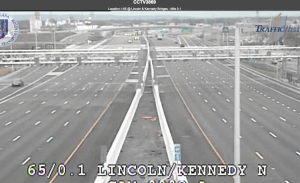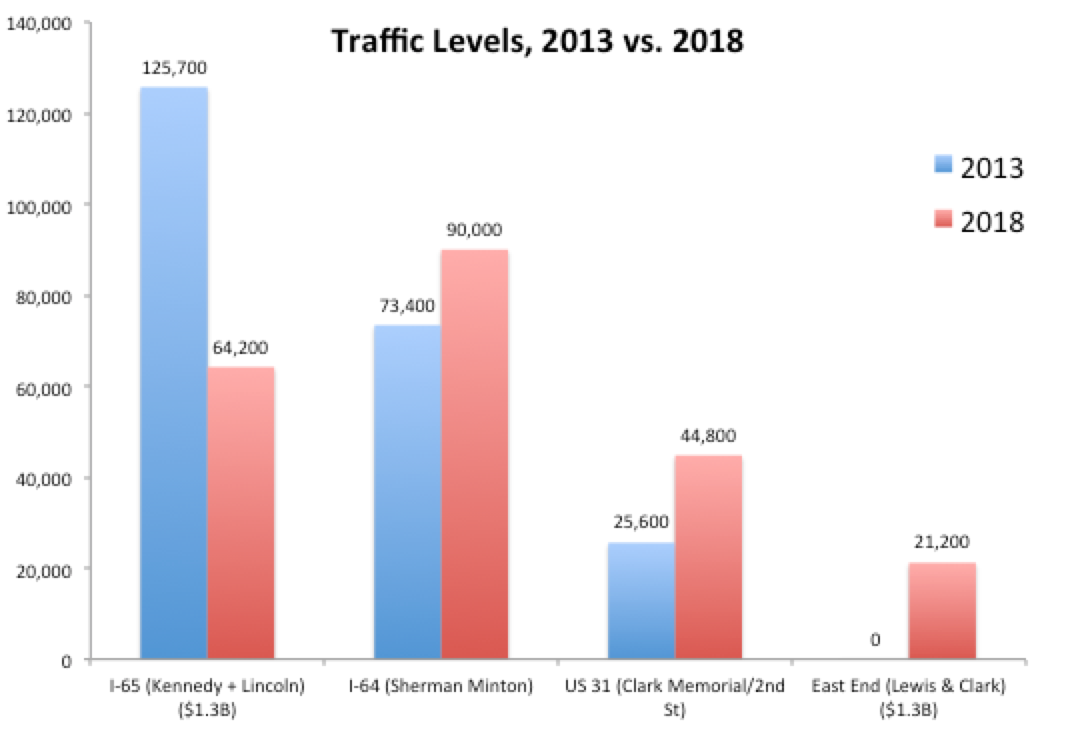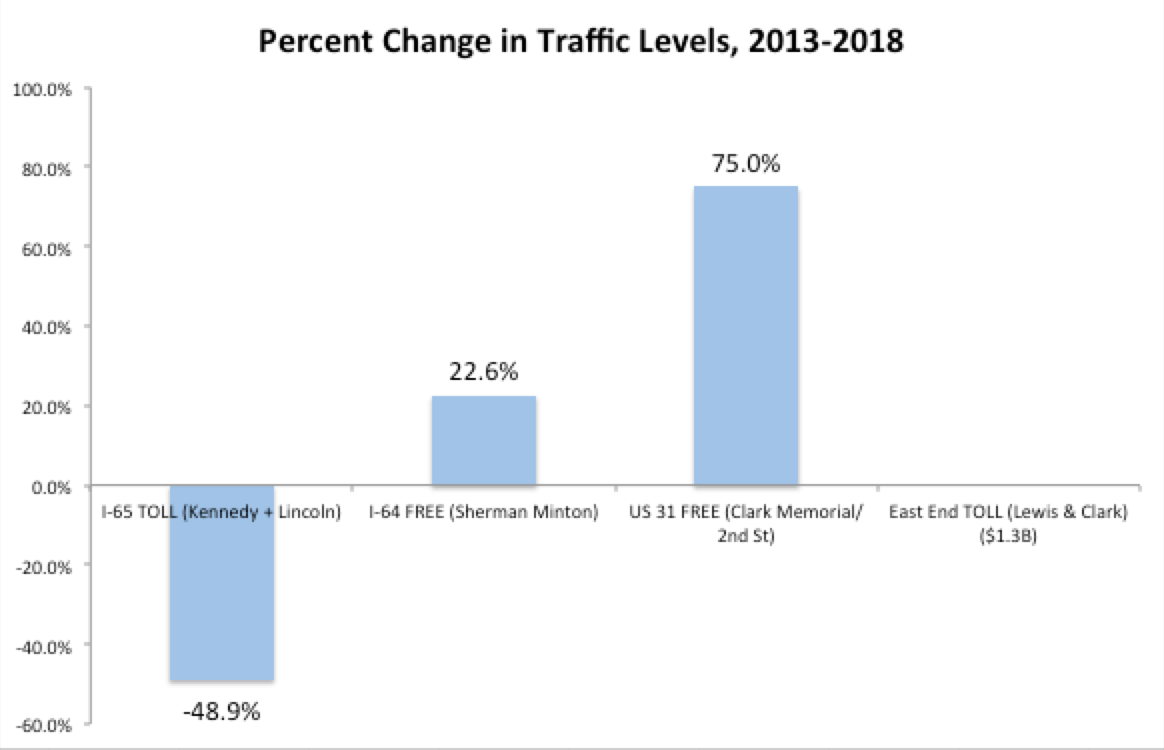
I have been a steadfast critic of the project to build two new bridges across the Ohio River in Louisville for over a decade. In fact, my first critical post on the bridges proposal was put up in 2007 less than six months after starting my original Urbanophile blog.
The end result was even worse than I anticipated. The project has proven to be a money waster of the highest order, and in fact by far the biggest American transportation boondoggle I can identify in the 21st century so far.
Part of the agreement between Indiana and Kentucky to build the bridges was that they would do official before and after surveys of traffic to determine the impact of the new bridges on traffic flow. The study was published in August of this year.
The result? The two states spent $1.3 billion dollars to build a parallel I-65 span in downtown Louisville that doubled the capacity of that crossing. After spending that money, traffic fell by 50%.
Let me repeat that: Indiana and Kentucky spent $1.3 billion to double the capacity of a road while traffic levels were cut in half.
Here’s a chart showing the before and after traffic levels on the bridges.

And here’s a percent change look.

The project doubled the size of the I-65 crossing and built a new East End crossing that didn’t previously exist. Each of these were around $1.3 billion separately.
What happened is that to pay for (part) of the bridges, a toll was added to the previously free I-65 bridge, and a new crossing in the East End was also tolled. This simply led to a diversion of traffic to the other two bridges that didn’t have tolls. In fact, the existing free I-64 Sherman Minton Bridge now carries more traffic than all of the toll bridges combined. (Unsurprisingly, there’s talk of temporarily closing that bridge for rehabilitation).
Total cross-river traffic has actually fallen since 2013, albeit only slightly. But traffic on the Clark Memorial (2nd Street) Bridge is up 75%. This is traffic choosing the free route to get to downtown. This happened even though the Clark Bridge has seen its number of lanes cut in half due to a lengthy repainting project. Traffic on the I-64 bridge increased by 23%. There’s no percent change on the East End bridge since it didn’t previously exist.
I have always said that the East End bridge made sense conceptually because it added a crossing where one did not exist previously and where traffic would otherwise have to go many miles out of the way to get across the river. The actual bridge was too expensive (also $1.3 billion or so), in part because of a ludicrous tunnel built on the Kentucky side, but at least the basic bridge was a sound project.
But an expanded downtown crossing never made sense. Not only has it proven to be a transportation waste, it is a negative in other ways. For example, the project doubled the width of interstate overpasses through downtown Louisville, creating a bigger barrier between downtown and the booming NuLu district to the East.
Most gallingly, Louisville decided to double down on freeways at a time when most cities are looking at ways to reduce the negative impact of freeways on downtowns and even tear them out entirely in some cases. A very viable proposal to do just that in Louisville called 8664 was rejected by policymakers, who insisted on spending $1.3 billion on this disaster.
Not only was this project a colossal waste of $1.3 billion. Not only did it harm the urban fabric of downtown Louisville. But there’s also reason to believe it diverted economic activity away from Louisville.
Looking at the numbers in table 3.1., it looks like truck traffic across the river has fallen by almost a third since 2013. Here’s the chart:

20% of 224,700 is 44,940. 14% of 220,200 is 30,828. That’s 14,112 trucks (i.e., commercial traffic) gone. Where did they go? If you are a region that’s banking on the distribution industry for a big part of your future blue collar employment growth, the tolls on these bridges can’t be good news. That’s particularly true when no surrounding competitor city has tolls.
I don’t generally like to say “I told you so” – but in this case I’ll make an exception. My analysis of this bridge project was known to decision makers well in advance of the project moving forward. I know that for a fact. What’s more, probably nothing harmed my standing in certain political circles more than this reportage. The 8664 idea was very widely circulated and understood by everyone in Louisville leadership.
This boondoggle didn’t happen by accident. It wasn’t a result of ignorance. It was well known in advance that it was a bad idea. It was a deliberate, conscious choice.
The fact that these states found $1.3 billion to spend on this downtown bridge is one reason why I will never again accept the “there’s no money for that” excuse on anything again. States keep finding plenty of money to spend on things of little to no value – like this bridges project.
I’m not hostile to road spending, so my opposition to this project was never based on an ideological opposition to cars but because it made no transportation or financial sense. It doesn’t make sense to build new roads in stagnant or shrinking places and we should be cautious about speculative projects in an age where we don’t know what the pending possible disruption of driverless cars might bring, but I’m a big advocate of building more roads in rapidly growing places. Unfortunately, the project selection process in most states seems to alight upon the worst projects while the best go unfunded.
Is there another place in the country where somebody spent $1.3 billion to double the capacity of a road whose traffic then fell by half? I can’t think of another example remotely like this. It may well be that something like the MTA East Side Access in New York has seen cost overruns that dwarf this. But at least that project will be useful when it’s done. This is a total waste. That’s why the Louisville downtown bridge is the biggest transportation boondoggle of the 21st century to date.
By rights I should be writing this for a major national publication instead of putting it on my personal web site. But I love Louisville and Southern Indiana (my hometown) and don’t want to create negative press for them. I just want it known for the record that this did not have to happen.
This piece originally appeared on Urbanophile.
Aaron M. Renn is a senior fellow at the Manhattan Institute, a contributing editor of City Journal, and an economic development columnist for Governing magazine. He focuses on ways to help America’s cities thrive in an ever more complex, competitive, globalized, and diverse twenty-first century. During Renn’s 15-year career in management and technology consulting, he was a partner at Accenture and held several technology strategy roles and directed multimillion-dollar global technology implementations. He has contributed to The Guardian, Forbes.com, and numerous other publications. Renn holds a B.S. from Indiana University, where he coauthored an early social-networking platform in 1991.
Photo Credit: Bart Evans, CC BY 2.0












